
Williamsport is a town in Washington County, Maryland, United States. The population was 1,868 at the 2000 census and 2,137 as of 2010.

Paw Paw is a town in Morgan County, West Virginia, United States. The population was 410 at the 2020 census. The town is known for the nearby Paw Paw Tunnel. Paw Paw was incorporated by the Circuit Court of Morgan County on April 8, 1891, and named after pawpaw, a wild fruit that grows in abundance throughout this region. On September 14, 2024 a group of local citizens organized by Maria Gloyd hosted the inaugural Pawpaw Festival in the Town Park. Hundreds of people attended the festival to hear lectures on how to grow and cultivate Pawpaw fruit, and listen to Appalachian music performed by the Paw Paw Community Choir, Ben Townsend, the Critton Hollow String Band, and Mary Hott with the Carpenter Ants. Paw Paw is the westernmost incorporated community in Morgan County, and the Hagerstown-Martinsburg, MD-WV Metropolitan Statistical Area.

Georgetown is a historic neighborhood and commercial district in Northwest Washington, D.C., situated along the Potomac River. Founded in 1751 as part of the colonial-era Province of Maryland, Georgetown predated the establishment of Washington, D.C. by 40 years. Georgetown was an independent municipality until 1871 when the United States Congress created a new consolidated government for the entire District of Columbia. A separate act, passed in 1895, repealed Georgetown's remaining local ordinances and renamed Georgetown's streets to conform with those in Washington, D.C.

The Chesapeake and Ohio Canal National Historical Park is located in the District of Columbia and the state of Maryland. The park was established in 1961 as a National Monument by President Dwight D. Eisenhower to preserve the neglected remains of the Chesapeake and Ohio Canal and many of its original structures.
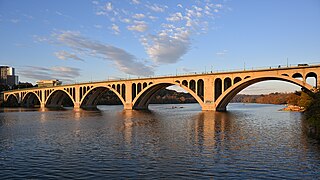
The Francis Scott Key Bridge, more commonly known as the Key Bridge, is a six-lane reinforced concrete arch bridge carrying U.S. Route 29 (US 29) across the Potomac River between the Rosslyn neighborhood of Arlington County, Virginia, and the Georgetown neighborhood of Washington, D.C. Completed in 1923, it is Washington's oldest surviving road bridge across the Potomac River.
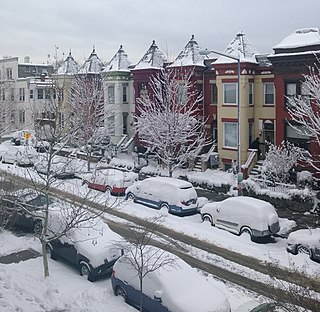
Bloomingdale is a neighborhood in the Northwest quadrant of Washington, D.C., less than two miles (3 km) north of the United States Capitol building. It is a primarily residential neighborhood, with a small commercial center near the intersection of Rhode Island Avenue and First Street NW featuring bars, restaurants, and food markets.

Oldtown is an unincorporated community and census-designated place (CDP) in Allegany County, Maryland, United States, along the North Branch Potomac River. As of the 2010 census, it had a population of 86.
The Chesapeake and Potomac Telephone Company, usually known as C&P Telephone, is a former d/b/a name for four Bell Operating Companies providing service to Washington, D.C., Maryland, West Virginia, and Virginia.

Piscataway Park is a National Park Service-protected area located 20 miles (32 km) southwest of downtown Washington, D.C. in and around Accokeek, Maryland. It protects the National Colonial Farm, Marshall Hall, and the Accokeek Creek Site. The park is located across the Potomac River from George Washington's Mount Vernon estate.
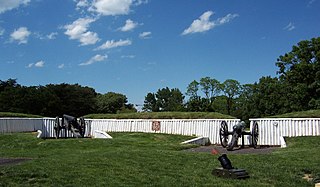
Fort Ward is a former Union Army installation now located in the city of Alexandria in the U.S. state of Virginia. It was the fifth largest fort built to defend Washington, D.C. in the American Civil War. It is currently well-preserved with 90-95% of its earthen walls intact.
The Chesapeake Gateways and Watertrails Network is a partnership program of the National Park Service and a system of over 150 parks, refuges, museums, historic communities and water trails in the Chesapeake Bay watershed. As a partnership program, it is not considered a Unit of the National Park System, but is managed by the National Park Service's Chesapeake Bay Office in Annapolis, Maryland, which also manages the Captain John Smith Chesapeake National Historic Trail and the Star-Spangled Banner National Historic Trail.

The Old Naval Observatory is a historic site at 23rd and E Street in Northwest, Washington, D.C. It is where the United States Naval Observatory was located from 1844 to 1893, when it moved to its present grounds. The original observatory building, built 1839-40, still stands, and is a designated National Historic Landmark as of 1965. The Washington meridian of 1850 passes through the Observatory.

District of Columbia City Hall, also known as Old City Hall and the District of Columbia Courthouse, is a historic building at Judiciary Square in downtown Washington, D.C. facing Indiana Avenue. Originally built for the offices of the government of the District of Columbia, the District's courthouse was subsequently used as a Federal courthouse, and was the scene of several notable criminal trials including those of three accused presidential assassins. The building was declared a National Historic Landmark in 1960. It now houses the District of Columbia Court of Appeals.

The Bowie Railroad Buildings comprise three small frame structures at the former Bowie train station, located at the junction of what is now the Northeast Corridor and the Pope's Creek Subdivision in the town center of Bowie, Maryland. The complex includes a single-story freight depot, a two-story interlocking tower, and an open passenger shed. The station was served by passenger trains from 1872 until 1989, when it was replaced by Bowie State station nearby. The buildings were restored in 1992 as the Bowie Railroad Museum and added to the National Register of Historic Places in 1998.
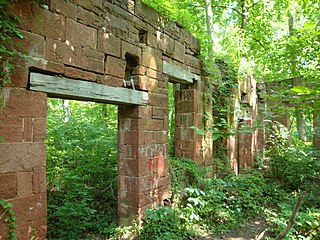
Seneca Quarry is a historic site located at Seneca, Montgomery County, Maryland. It is located along the Chesapeake and Ohio Canal on the north bank of the Potomac River, just west of Seneca Creek. The quarry was the source of stone for two Potomac River canals: the Patowmack Canal on the Virginia side of Great Falls; and the C&O Canal, having supplied red sandstone for the latter for locks 9, 11, 15 - 27, and 30, the accompanying lock houses, and Aqueduct No. 1, better known as Seneca Aqueduct, constructed from 1828 to 1833.

Knoxville is an unincorporated community in Frederick and Washington counties, Maryland, United States. The Robert Clagett Farm and Magnolia Plantation are listed on the National Register of Historic Places.
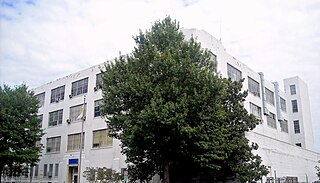
The Chesapeake and Potomac Telephone Company Warehouse and Repair Facility is an Art Deco industrial building, located at 1111 North Capitol Street, Northeast, Washington, D.C., in the NoMa neighborhood which houses the headquarters of National Public Radio.

The Chesapeake and Potomac Telephone Company Building is a historic structure located in Downtown Washington, D.C. It was listed on the National Register of Historic Places in 1988.

















